IN THIS ISSUE
- Swirling kettles of kites
- Reader survey and giveaway
- Hot nectar troubles hummers?
- Sobering totals from rainy bat blitz
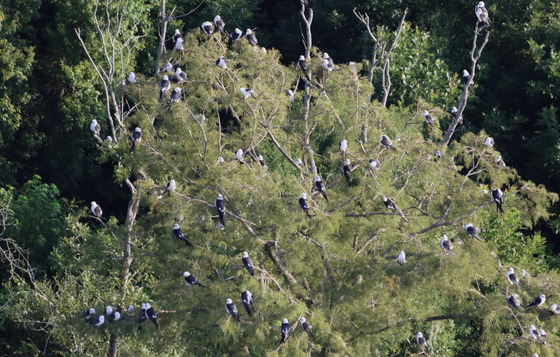 Swallow-tailed kites crowd a treetop at the roost along the Altamaha River (Tim Keyes/DNR)
From their graceful, swivel-tailed flights to vivid black-and-white markings, swallow-tailed kites are must-see raptors. Which makes the recent discovery of the largest swallowtail roost documented in Georgia even more eye-catching.
Following up on a satellite-tagged kite, DNR wildlife technician Andy Day found the roost in early August along the Altamaha River south of Glennville. A count by helicopter totaled 612 kites.
Wildlife biologist Tim Keyes first visited the roost by boat. “It was like swirling kettles of kites,” he said.
Each year about 150-200 pairs of swallow-tailed kites nest in Georgia. Most of these birds, a species of conservation concern in the State Wildlife Action Plan, nest on the lower stretches of the Satilla and Altamaha rivers. Some nests are scattered along other south Georgia rivers.
After nesting and before the kites migrate to South America, in late summer the birds gather in roosts at night and feed by day on insects over fields and other open areas. In southeast Georgia, the foraging can involve large groups. The Altamaha roost, which is on private land in tall trees along drainages and the river, feeds “some of those big foraging aggregations that people like to see,” Keyes said.
It’s unknown if the roost is primarily made up of kites that nested in Georgia and South Carolina, or if it includes numerous kites from Florida. During the post-breeding season, some swallowtails fly north for a brief time before migrating south. Nocturnal roosts in Florida can number more than 2,000 kites.
Nor is it clear how long the roost has been there. Gathering sites can shift, Keyes said. “This was a river stretch where we’ve had clusters of roosting kites before.”
What is clear is that as of early August the roost had more swallow-tailed kites in one place than all of the kites counted in an entire day of aerial roost surveys on the Savannah, Ogeechee, Altamaha and Satilla.
“Even combining the river systems,” Keyes said of those late-July surveys from 2009-2011, “we never had 600-plus birds total. Our highest one-day count across all the rivers was under 500 birds.”
For more on swall0wtail foraging aggregations, see the Wild Fact below.
 Georgia Wild readers, we want to know what you think about the newsletter.
And for your thoughts, we’re offering the chance to win a classy DNR cap.
But cap or not, you win. That’s because your feedback will help improve Georgia Wild. Which will result in more of the wildlife news you want, plus a few fun surprises, delivered free to your inbox each month.
So what are you waiting for? Click the button below, take the survey (about seven minutes tops) and, to be added to a drawing for one of 10 caps, provide your email.
But do it soon. The survey closes Sept. 14. If you win a hat, we'll let you know by Sept. 25.
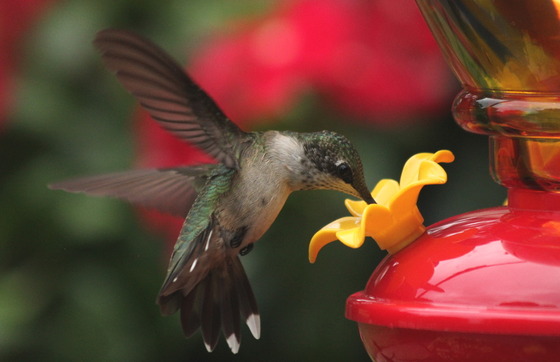 Ruby-throated hummingbird at a feeder (Ricki Forbes/GNPA)
By TERRY W. JOHNSON
Before I retreated to the pleasant temperatures in my home office to write this column, I was standing on my deck of my middle Georgia home watching hungry hummingbirds circling two feeders hanging from a shepherd’s hook.
Since the air temperature was 95 degrees Fahrenheit and the heat index was a Sahara desert-like 115, sweat was dripping from my brow. But that torrid, unrelenting summer heat was also heating the sugar water in the nearby feeders.
When it is this hot, hummingbird fans across Georgia and much of the rest of the nation are beginning to wonder if the “hot” nectar in their feeders might be harmful to the beautiful birds they are trying to help. …
Read Terry’s column for more on hummers, heat and what bird lovers can do.
Terry W. Johnson is a retired DNR manager and executive director of TERN, friends group of the Wildlife Conservation Section. Check out past columns and his blog. Permission is required to reprint a column.
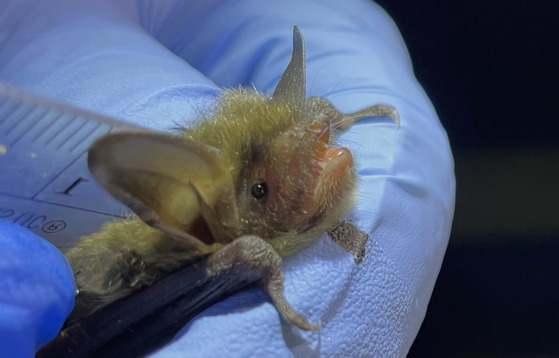 Endangered northern long-eared bat caught, released in Georgia blitz (Special to DNR)
Despite rain soaking the Southeastern Bat Diversity Network’s first bat blitz in Georgia in 13 years, the all-hands-on-deck effort to provide a snapshot of local bat populations rated a success.
The survey canvassing northwest Georgia near Chatsworth last month totaled 98 bats captured, assessed and released, plus the first northern long-eared bat documented in Georgia since 2017.
Trina Morris, a program manager with DNR’s Wildlife Conservation Section, said finding the federally endangered species was a thrill. “It was a lone male that came out of a mine, so we could not track it. But it gives us a place to start when investigating the possibility of survivors that may be reproducing.”
Held annually by the Bat Diversity Network at sites in the Southeast, the blitz is an intense effort by scientists, volunteers and others to survey bats in a large area for about three straight nights. The team approach to checking abundance and species diversity yields in a few days data that can take a single agency or organization an entire field season to gather.
Morris and fellow biologist Emily Ferrall hoped the recent blitz would also give a clear before-and-after look at the Fort Mountain area, also for Georgia's previous blitz in 2010. Three years after that survey, researchers documented the first record of white-nose syndrome in the state. The fungal disease fatal for bats has ravaged populations across North America.
About 30 of the mist-net locations for the latest blitz – including sites on national forest and state and U.S. Army Corps of Engineer lands – were the same as those in 2010, before white-nose appeared.
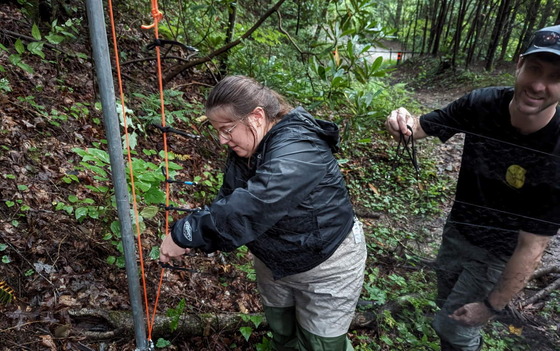 Setting a mist net on a Chattahoochee National Forest road (Special to DNR)
Thunderstorms on two evenings this year scrambled travel plans and when nets were set, clouding comparisons between the two surveys. However, there’s no doubt that white-nose played a significant role in the steep drop-off in some bat counts, with 294 caught in 2010 and not quite 100 this year.
“We did have more weather issues this year than in 2010,” Morris said, “so our capture numbers overall should be a little higher, especially for some of the more common species like eastern red and big brown bats.”
Yet she also explained that species most affected by white-nose and once regularly found in the region are now “nearly absent.” For example, the 2010 blitz recorded 89 northern long-eared and 65 tricolored bats. The totals this year: one of each.
Northern long-eared bats are endangered because of deaths from white-nose. Tricolored bats are proposed for federal listing as endangered for the same reason.
Data from the blitz will be used to help conserve Georgia bats.
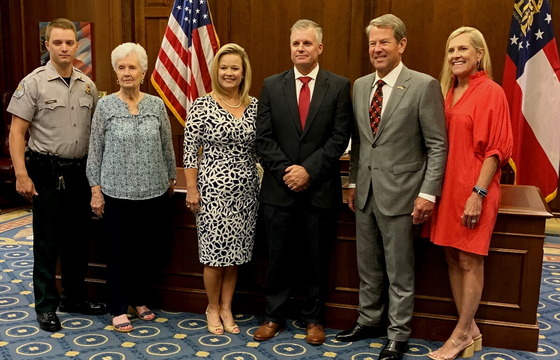 DNR Commissioner Walter Rabon with his family and Gov. Brian and First Lady Marty Kemp (Office of the Governor)
Thirty years after starting with DNR as a game warden, Walter Rabon is the agency's new commissioner. Rabon, who worked his way to major in the Law Enforcement Division before being promoted to deputy commissioner, was nominated for commissioner by Gov. Brian Kemp and approved by the Board of Natural Resources last month. Kemp said the Mansfield resident dedicated years to “the mission of protecting hardworking Georgians and their ability to enjoy the outdoors” and with Rabon’s leadership he looked “forward to DNR’s continued success ensuring our state is a good steward of its natural resources.” Rabon had served as interim commissioner since July 1, when former Commissioner Mark Williams stepped down to become the Jekyll Island Authority’s executive director.
A reminder for Georgians who own newly regulated reptile species as pets: Dec. 4 is the deadline to tag and register these herps. Indian rock and Burmese pythons, Argentine black and white tegus, Nile monitors, African helmeted turtles, and Chinese softshell turtles were added to the state’s wild animal list in 2022, requiring PIT-tagging and registration to keep them as pets.
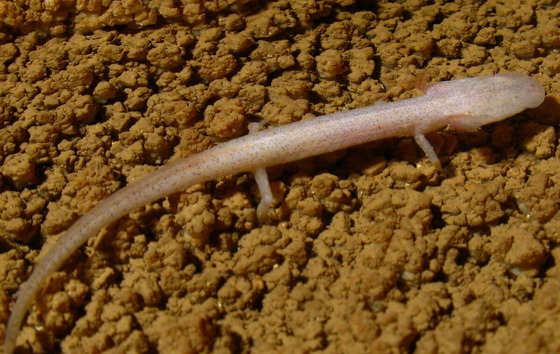 Georgia blind salamander (Alan Cressler)
Tennessee heelsplitter mussels and Georgia blind salamanders, both found in Georgia, do not warrant listing under the Endangered Species Act, the U.S. Fish and Wildlife Service has announced. But after a thorough review, Fish and Wildlife has proposed listing both the Tennessee pigtoe and Cumberland moccasinshell, freshwater mussel species known or thought to occur in the state, as endangered.
In the wake of Idalia, DNR worked around the clock – removing debris, providing security and offering other assistance – to help Georgians rebound. The hurricane surged from Florida into south-central Georgia early Aug. 30 and swept east, toppling trees, damaging homes, flooding roads and knocking out power.
Think you’ve seen a yellow-legged hornet? Report possible sightings of the 2-inch-long invaders, first documented in the U.S. near Savannah last month (and the nest destroyed), at this state Agriculture Department website. (Also, here’s a guide to yellow-legged – or northern giant – hornets and some lookalikes.)
 Two 2023 winners: Arnold Elementary's Gabrielle Perry, left; Oglethorpe Avenue Elementary's Lyla Maldonado Wells
The Give Wildlife a Chance Poster Contest is asking K-5 students to illustrate the natural resources that make up a plant or animal’s home. “What’s that? Habitat!” is the theme for the 34th annual competition led by DNR, the State Botanical Garden of Georgia and The Environmental Resources Network to increase awareness and appreciation among youth for the state’s wide variety of wildlife.
Fall gatherings focused on conservation include a DNR and Quail Forever quail habitat workshop (Sept. 15 at Di-Lane Wildlife Management Area near Waynesboro), the Georgia Sea Turtle Cooperative’s nesting-season wrap-up (Sept. 22 at DNR offices in Brunswick), the annual Georgia Prescribed Fire Council meeting (Sept. 25 at the National Infantry Museum in Columbus) and the Upper Coosa Conservation Summit (Oct. 25 at Berry College in Rome).
 The Lovett School's Vanessa Boone received the conservation teacher grant last year. (Linda May/DNR)
Quick hits:
- DNR and The Environmental Resources Network are again offering a $1,000 grant to a K-5 educator who qualifies as Conservation Teacher of the Year.
- The hunt is on: dove season opened last weekend and archery for deer starts Saturday.
-
Here’s how you can help keep chronic wasting disease (CWD) out of Georgia.
- What’s rare, 2 inches long and has bright red lips? (Hint: Read the blog post.)
- While northern mockingbirds usually nest not far off the ground, an Atlanta pair took it to a new level, nesting in the garden of a 35th-floor condo, DNR’s Dr. Bob Sargent writes in The Oriole, a Georgia Ornithological Society journal.
- Don't let your Bearwise guard down: Bears feeding for winter and moms helping cubs forage will not pass up unsecured trash, pet food and bird seed.
- DNR Wildlife Resources Division almost repeated its 2022 social media showing at this year’s Association of Conservation Information conference, placing second in Conservation Post of the Year (“Bears Don’t Have Collar Bones”) and Best Social Campaign (“Creepy Critter Week,” i.e., shedding velvet and other weirdness).
Names in the news: DNR senior wildlife technician Bryan “Hootie” Crowe received the National Bobwhite and Grassland Initiative’s Firebird Award for his work improving quail habitat on Chickasawhatchee, Elmodel and Albany Nursery wildlife management areas in southwest Georgia. Cpl. Tyler Lewis, assigned to Cobb County, is DNR Game Warden of the Year. Game Warden 1st Class Jared Wood, from Fannin County, received the James R. Darnell Award as runner-up. In other DNR moves, Jeff Cown, former head of Georgia’s State Parks and Historic Sites Division, was named director of the Environmental Protection Division and Angie Johnson was promoted to parks director from assistant director.
 "To Save a Plant," Georgia Outdoors episode highlighting the Georgia Plant Conservation Alliance
(+audio) "Southeastern Bat Blitz explores spread of bat-killing fungus," WABE-FM (90.1, Atlanta)
"Attention: Chronic Wasting Disease," DNR
(audio) "Snakebite in Dogs with Dr. Michael Schaer," Snake Talk (Orianne Society podcast)
"WildTail" (trailer), Southeastern Deer Partnership
"Mapping to monitor: how invasive species spread during Georgia floods," Savannah Morning News
"After helping prevent extinctions for 50 years, Endangered Species Act may be in peril," Associated Press
"Georgia’s bald eagle population continues to rise despite challenges," WUGA-FM (91.7 and 94.5, Athens)
"Return of the northern long-eared bat," AllonGeorgia
"Featherfield Farms sold to DNR for habitat conservation, expanded access," Thomasville Times-Enterprise
"ACF Basin workshop: Mussel lovers gather at Jones Center," U.S. Fish and Wildlife Service
"DNR offers options to fight deer, feral hog crop damage," Morning Ag Clips
(+video) "First yellow-legged hornet nest in U.S. eradicated in Savannah area," WSAV-TV (ch. 3, Savannah)
"After Supreme Court curtails federal power, Biden administration weakens clean water protections," Associated Press
"Give Wildlife a Chance Poster Contest focuses on wildlife diversity," The McDuffie Progress and others
"Georgia Grows Native for Birds month returns," SaportaReport
"DNR offers $1,000 grant for top conservation teacher," Marietta Daily Journal
"Ga. woman’s audacious plan: Build longest U.S. paved bike trail," The Atlanta Journal-Constitution
"Recovery plan for whorled sunflower announced," U.S. Fish and Wildlife Service
"Tagging study targets blue catfish in Satilla River," EIN News
"Carter proposes bill to block NOAA from reducing boat speed limits," WTOC-TV (ch. 11, Savannah)
"Microplastics found in whales, dolphins, seals, sparking human health concerns," The Conversation (study in ScienceDirect)
"DNR schedules Outdoors Woman workshop," Morgan Citizen (Madison)
"Georgia’s Black churches look to go green," The Current
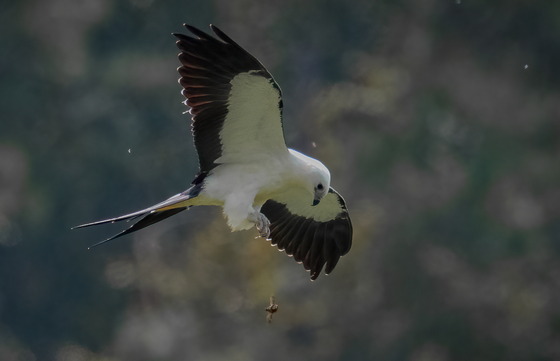 A swallow-tailed kite swoops in on a June beetle in Tattnall County. (Brian Mitchell)
Swallow-tailed kites in the U.S. migrate from the Southeast to South America each fall. But the journey requires preparation. From late July into August, areas buzzing with insects – such as pastures and newly mown hayfields in south Georgia – can draw flocks or aggregations of swallow-tailed kites, sometimes 50 or more and often including Mississippi kites. The aerobatic black-and-white swallowtails spend mornings filling up on June beetles (often called June bugs), dragonflies and other insects, most caught and eaten in flight, before winging it south for the winter.
– Ethan Hatchett
CREDIT
Masthead: swallow-tailed kite (Brian Mitchell)
Top
|